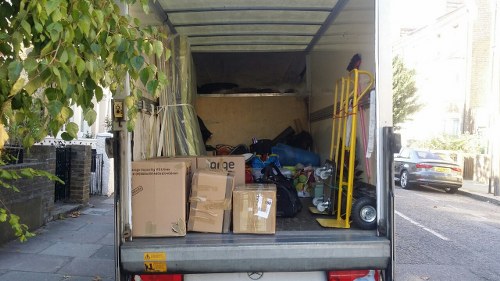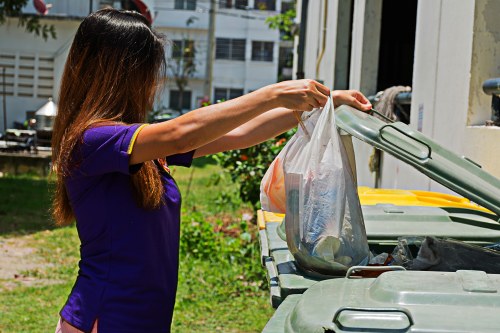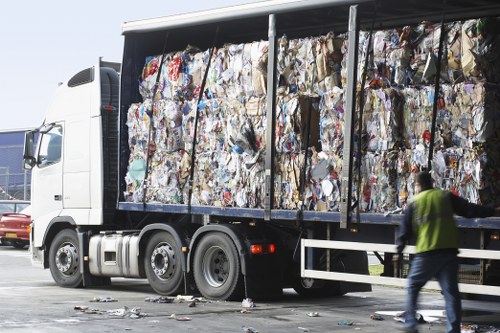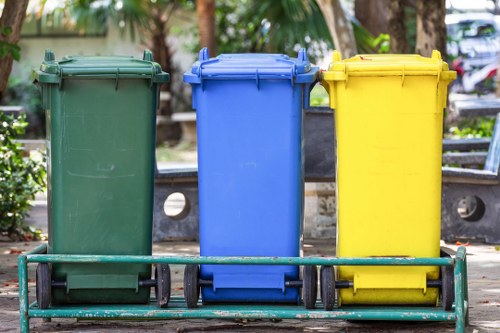Comprehensive Guide to Construction Waste Clearance in Turnham Green
Understanding Construction Waste Clearance

Construction projects are essential for the development and maintenance of urban areas. However, they often generate a significant amount of construction waste, which can pose environmental and logistical challenges. Proper waste clearance is crucial to ensure that construction sites remain safe, efficient, and environmentally responsible.
In Turnham Green, a vibrant area known for its historical significance and modern developments, managing construction waste effectively is particularly important. With ongoing projects ranging from residential buildings to commercial complexes, the demand for reliable waste clearance services is high.
Effective construction waste clearance not only helps in maintaining the aesthetic appeal of the area but also contributes to sustainability by promoting recycling and reducing landfill usage. Understanding the various aspects of waste clearance can help property developers, contractors, and homeowners make informed decisions.
Types of Construction Waste

Construction waste can be broadly categorized into several types, each requiring specific handling and disposal methods:
- Concrete and Masonry: Includes broken bricks, tiles, and concrete debris.
- Wood Waste: Offcuts, pallets, and untreated wood products.
- Metals: Steel beams, aluminum scraps, and other ferrous and non-ferrous metals.
- Plastics: Packaging materials, pipes, and plastic fittings.
- Glass: Windows, bottles, and other glass products.
- Hazardous Waste: Asbestos, lead-based paints, and chemical substances.
Proper classification and segregation of these materials at the source can significantly enhance the efficiency of the waste clearance process.
Local Regulations and Compliance in Turnham Green

Compliance with local regulations is a critical aspect of construction waste clearance in Turnham Green. The borough has established specific guidelines to ensure that waste management practices are environmentally sound and adhere to legal standards.
Key Regulations Include:
- Waste Disposal Permits: Required for large-scale waste removal operations.
- Segregation Standards: Mandates the separation of recyclable materials from general waste.
- Recycling Targets: Encourages contractors to recycle a certain percentage of their waste.
- Hazardous Waste Handling: Strict protocols for disposing of hazardous materials safely.
Non-compliance can result in hefty fines and project delays, making it imperative for businesses to stay informed and adhere to these regulations diligently.
Benefits of Professional Waste Clearance Services

Engaging professional waste clearance services in Turnham Green offers numerous advantages:
- Efficiency: Professionals can manage waste quickly, ensuring that construction timelines remain on track.
- Safety: Proper handling reduces the risk of accidents on-site.
- Environmental Protection: Experts ensure that waste is processed sustainably, minimizing environmental impact.
- Cost-Effectiveness: Reduces potential fines and disposal costs through efficient waste management.
- Compliance Assurance: Ensures that all activities meet local regulations and standards.
Choosing the right service provider can make a significant difference in the overall success of your construction project.
Selecting the Right Waste Clearance Partner

When it comes to selecting a waste clearance partner in Turnham Green, several factors must be considered:
- Experience and Expertise: Look for companies with a proven track record in handling construction waste.
- Range of Services: Comprehensive services that cover all types of waste are preferable.
- Environmental Practices: Ensure the company follows sustainable practices, including recycling and proper disposal.
- Compliance: The provider should be familiar with local regulations and possess necessary permits.
- Customer Reviews: Positive feedback and testimonials can indicate reliability and quality of service.
Investing time in selecting the right partner can lead to smoother project execution and better environmental outcomes.
Steps in the Waste Clearance Process
Understanding the typical steps involved in construction waste clearance can help in planning and execution:
- Assessment: Evaluating the amount and type of waste generated.
- Segregation: Sorting waste into different categories for appropriate handling.
- Collection: Transporting waste from the site to designated facilities.
- Processing: Recycling or disposing of waste based on its category.
- Reporting: Documenting waste management activities for compliance purposes.
Each step requires meticulous planning and execution to ensure that waste clearance is efficient and compliant with all regulations.
Environmental Impact of Construction Waste
Construction waste, if not managed properly, can have severe environmental repercussions:
- Landfill Overload: Increases the burden on landfill sites, leading to faster depletion of available space.
- Pollution: Leaching of toxic substances from waste can contaminate soil and water sources.
- Resource Wastage: Discarding recyclable materials results in the loss of valuable resources.
- Greenhouse Gas Emissions: Decomposition of organic waste and incineration contribute to carbon emissions.
Implementing effective waste clearance strategies can mitigate these impacts and promote a healthier environment.
Innovative Practices in Waste Management
The construction industry is adopting several innovative practices to enhance waste management:
- Recycling and Reuse: Materials like metal, wood, and concrete are being recycled or repurposed for other projects.
- Waste-to-Energy: Converting waste into energy through processes like incineration.
- Digital Waste Tracking: Using software to monitor waste generation and disposal, ensuring transparency and efficiency.
- Modular Construction: Prefabrication reduces waste by minimizing on-site cutting and adjustments.
These practices not only reduce environmental impact but also offer economic benefits by lowering waste disposal costs.
Cost Factors in Waste Clearance
The cost of construction waste clearance can vary based on several factors:
- Volume of Waste: Larger projects generate more waste, increasing disposal costs.
- Type of Waste: Hazardous or non-recyclable materials may incur higher fees.
- Frequency of Collection: Regular pickups can lead to cost savings compared to infrequent services.
- Transportation Distance: Longer distances to disposal sites can increase costs.
- Additional Services: Services like on-site segmentation or detailed reporting may add to the overall price.
Understanding these cost factors can help in budgeting and selecting appropriate services that offer the best value.
Best Practices for Effective Waste Management
Adopting best practices in waste management can lead to more efficient and sustainable operations:
- Early Planning: Incorporate waste management plans during the project design phase.
- Training and Education: Educate workers on proper waste segregation and handling.
- Regular Audits: Conduct audits to monitor waste generation and disposal practices.
- Collaborate with Local Authorities: Stay updated with regulations and seek guidance when needed.
- Invest in Technology: Utilize digital tools for tracking and managing waste efficiently.
Implementing these practices can enhance the overall effectiveness of waste clearance efforts.
Recycling Initiatives in Turnham Green
Turnham Green is actively promoting recycling initiatives as part of its waste management strategy:
- Material Recovery Facilities: Local facilities are equipped to process various construction materials.
- Public Awareness Campaigns: Efforts to educate the community about the benefits of recycling.
- Incentive Programs: Discounts and incentives for contractors who prioritize recycling.
- Partnerships with Recycling Companies: Collaborations to ensure efficient processing of recyclable materials.
These initiatives not only reduce the environmental impact but also foster a culture of sustainability within the community.
Case Studies: Successful Waste Clearance Projects
Examining successful waste clearance projects in Turnham Green can provide valuable insights:
- Residential Development: A large-scale housing project implemented on-site segregation, resulting in a 60% recycling rate.
- Commercial Complex: Utilized waste-to-energy solutions, significantly reducing landfill dependency.
- Renovation Project: Partnered with local recycling facilities to process and repurpose materials, minimizing waste.
These case studies highlight the effectiveness of strategic waste management practices in achieving sustainability goals.
Future Trends in Construction Waste Clearance
The landscape of construction waste clearance is evolving, with several emerging trends shaping the future:
- Circular Economy Models: Emphasizing the reuse and recycling of materials to create a closed-loop system.
- Advanced Sorting Technologies: Utilizing AI and robotics for more efficient waste segregation.
- Green Building Certifications: Encouraging sustainable construction practices through certifications like LEED.
- Blockchain for Transparency: Enhancing traceability and accountability in waste management.
- Biodegradable Materials: Adoption of materials that have minimal environmental impact.
Staying abreast of these trends can help stakeholders in Turnham Green adapt and innovate in their waste clearance strategies.
Challenges in Construction Waste Clearance
Despite advancements, several challenges persist in effective construction waste clearance:
- High Disposal Costs: Managing and disposing of waste can be financially burdensome.
- Lack of Awareness: Insufficient knowledge about waste management practices among workers.
- Regulatory Compliance: Navigating complex regulations can be daunting for businesses.
- Limited Recycling Facilities: Inadequate infrastructure for processing certain types of waste.
- Market Fluctuations for Recyclables: Variable demand and prices for recyclable materials.
Addressing these challenges requires concerted efforts from all stakeholders involved in the construction industry.
Conclusion
Construction waste clearance in Turnham Green is a multifaceted process that plays a vital role in sustaining the area's development while protecting the environment. By understanding the types of construction waste, adhering to local regulations, and adopting best practices, stakeholders can ensure efficient and responsible waste management.
Engaging professional waste clearance services not only enhances operational efficiency but also contributes to a greener and more sustainable community. As the industry continues to evolve, embracing innovative practices and overcoming existing challenges will be key to achieving long-term success in construction waste management.
If you're planning a construction project in Turnham Green, contact us today to ensure your waste clearance needs are handled professionally and responsibly. Book your service now and contribute to a sustainable future.